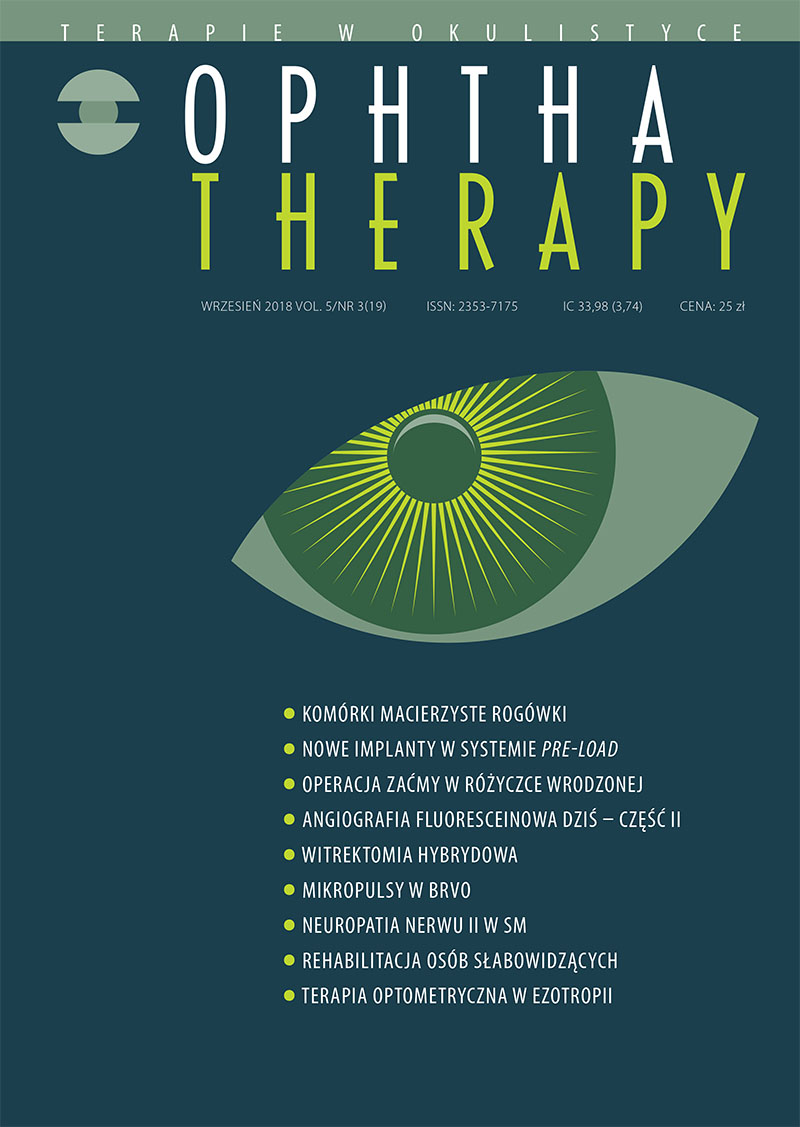Efektywność optometrycznej terapii wzroku w akomodacyjnej ezotropii z wysokim AC/A
##plugins.themes.bootstrap3.article.main##
Abstrakt
Akomodacyjna ezotropia z nadmierną konwergencją jest stanem, w którym korekcja nadwzroczności redukuje kąt zeza do dali, natomiast w bliży oczy pozostają ustawione w zezie zbieżnym. Wśród metod korekcji zeza tego typu można wyróżnić zastosowanie okularów dwuogniskowych oraz zabieg chirurgiczny na mięśniach okoruchowych. Jednak skuteczność obu tych podejść w uzyskaniu widzenia stereoskopowego pozostaje wątpliwa. Niniejsza praca opisuje przypadek 10-letniej pacjentki z akomodacyjną ezotropią z wysokim ułamkiem AC/A, u której zastosowana optometryczna terapia wzroku wspomagana korekcją dwuogniskową znacząco poprawiła funkcję widzenia oraz zredukowała symptomy wzrokowe. Przypadek ten pokazuje, że w postępowaniu ze stanami zezowymi bardzo istotne jest wyprowadzenie zaburzeń akomodacyjnych i okoruchowych oraz tłumienia międzyocznego, co pozwala na uzyskanie lepszej kontroli okulomotorycznej i widzenia stereoskopowego.
Pobrania
##plugins.themes.bootstrap3.article.details##

Utwór dostępny jest na licencji Creative Commons Uznanie autorstwa – Użycie niekomercyjne – Bez utworów zależnych 4.0 Międzynarodowe.
Copyright: © Medical Education sp. z o.o. License allowing third parties to copy and redistribute the material in any medium or format and to remix, transform, and build upon the material, provided the original work is properly cited and states its license.
Address reprint requests to: Medical Education, Marcin Kuźma (marcin.kuzma@mededu.pl)
Bibliografia
2. Sefi-Yurdakul N, Kaykisiz H, Koc F. The effects of partial and full correction of refractive errors on sensorial and motor outcomes in children with refractive accommodative esotropia. Int Ophthalmol. 2018 [Epub ahead of print].
3. Uretmen O, Kose S, Oztas Z et al. Factors influencing stereoacuity in refractive accommodative esotropia. Can J Ophthalmol. 2007; 42: 600-4.
4. Lambert SR, Lynn M, Sramek J et al. Clinical features predictive of successfully weaning from spectacles those children with accommodative esotropia. J AAPOS. 2003; 7: 7-13.
5. Lee HJ, Kim SJ, Yu YS. Stereopsis in patients with refractive accommodative esotropia. J AAPOS. 2017; 21: 190-5.
6. Tejedor J, Gutierrez-Carmona FJ. Amblyopia in High Accommodative Convergence/Accommodation Ratio Accommodative Esotropia. Influence of Bifocals on Treatment Outcome. Am J Ophthalmol. 2018; 191: 124-8.
7. Pratt-Johnson JA, Tillson G. Sensory outcome with nonsurgical management of esotropia with convergence excess (a high accommodative convergence/accommodation ratio). Can J Ophthalmol. 1984; 19: 220-3.
8. Whitman MC, MacNeill K, Hunter DG. Bifocals Fail to Improve Stereopsis Outcomes in High AC/A Accommodative Esotropia. Ophthalmology. 2016; 123: 69096.
9. Somer D, Cinar FG, Oral B et al. Combined recession and resection surgery in the management of convergence excess esotropia with different levels of AC/A ratio. J AAPOS. 2017; 21: 7e1-7.
10. West CE, Repka MX. A comparison of surgical techniques for the treatment of acquired esotropia with increased accommodative convergence/accommodation ratio. J Pediatr Ophthalmol Strabismus. 1994; 31: 232-7.
11. Millicent M, Peterseim W, Buckley EG. Medial rectus fadenoperation for esotropia only at near fixation. J AAPOS. 1997; 1: 129-33.
12. Akar S, Gokyigit B, Sayin N et al. Medial rectus Faden operations with or without recession for partially accommodative esotropia associated with a high accommodative convergence to accommodation ratio. Br J Ophthalmol. 2013; 97: 83-7.
13. Arnoldi K, Shainberg M. High AC/A ET: Bifocals? Surgery? Or Nothing at All? Am Orthopt J. 2005; 55: 62-75.
14. Vivian AJ, Lyons CJ, Burke J. Controversy in the management of convergence excess esotropia. Br J Ophthalmol. 2002; 86: 923-9.
15. Griffin JR, Grisham JD. Binocular Anomalies: Diagnosis And Vision Therapy. Butterworth-Heinemann, Boston 2002.
16. Ciuffreda KJ, Rumpf D. Contrast and accommodation in amblyopia. Vision Res. 1985; 25: 1445-57.
17. Manh V, Chen AM, Tarczy-Hornoch K et al. Accommodative performance of children with unilateral amblyopia. Invest Ophthalmol Vis Sci. 2015; 56: 1193-207.
18. Singh V, Agrawal S. Visual functions in amblyopia as determinants of response to treatment. J Pediatr Ophthalmol Strabismus. 2013; 50: 348-54.
19. Toor S, Horwood AM, Riddell P. Asymmetrical accommodation in hyperopic anisometropic amblyopia. Br J Ophthalmol. 2018; 102: 772-8.
20. Nawrot P, Michalak KP, Przekoracka-Krawczyk A. Does home-based vision therapy affect symptoms in young adults with convergence insufficiency? Optica Applicata. 2013; 43(3): 551-66. https://doi.org/10.5277/oa130314.
21. Caloroso EE, Rouse MW, Cotter S. Clinical Management of Strabismus. Butterworth-Heinemann, Boston 1993.
22. Przekoracka-Krawczyk A, Michalski A, Wojtczak-Kwaśniewska M. Visual Therapy in Open Space Rehabilitation of Acquired Visual Field Defect. Neuropsychiatry (London). 2018; 8(5): 1527-32. https://doi.org/ 10.4172/Neuropsychiatry.1000487.
23. Wilson ME, Bluestein EC, Parks MM. Binocularity in accommodative esotropia. J Pediatr Ophthalmol Strabismus. 1993; 30: 233-36.

